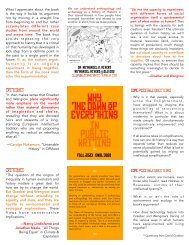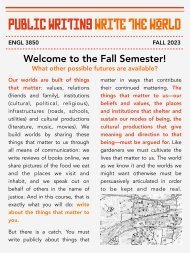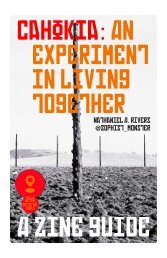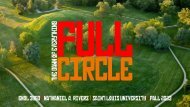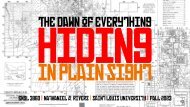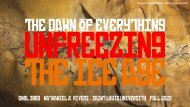Create successful ePaper yourself
Turn your PDF publications into a flip-book with our unique Google optimized e-Paper software.
<strong>Cahokia</strong>: <strong>An</strong><br />
experiment<br />
<strong>in</strong> liv<strong>in</strong>g<br />
tOgether <br />
Nathaniel A. Rivers<br />
@sOphist_mOnster<br />
A Z<strong>in</strong>e Guide
This z<strong>in</strong>e works to create a unique way of explor<strong>in</strong>g<br />
<strong>Cahokia</strong> Mounds, IL. The z<strong>in</strong>e treats <strong>Cahokia</strong> as the<br />
remnants of an experiment <strong>in</strong> and experience of liv<strong>in</strong>g<br />
together. <strong>An</strong>d it engages <strong>Cahokia</strong> as such <strong>in</strong> order to use<br />
<strong>Cahokia</strong> to th<strong>in</strong>k about the city of Sa<strong>in</strong>t Louis, MO. There is<br />
a temptation to understand cities—or any public—as <strong>in</strong>ert<br />
conta<strong>in</strong>ers <strong>in</strong> which th<strong>in</strong>gs happen, <strong>in</strong> which we live our<br />
lives. But cities, as publics, are other than this. Writ<strong>in</strong>g<br />
about <strong>Cahokia</strong>, author <strong>An</strong>nalee Newitz writes <br />
Cities are ongo<strong>in</strong>g social experiments, and the rema<strong>in</strong>s<br />
of ancient homes and monuments are half-erased lab<br />
notes left by our ancestors. They describe how people<br />
tried to br<strong>in</strong>g diverse groups together with a shared<br />
purpose, to nourish and enterta<strong>in</strong> each other, to overcome<br />
political conflict and climate catastrophe. They also<br />
describe our failures: the authoritarian slave-driv<strong>in</strong>g<br />
leadership, the bad civil eng<strong>in</strong>eer<strong>in</strong>g, and the laws that<br />
limited many people’s access to resources. Our forebears’<br />
eroded palaces and villas warn us about how communities<br />
can go wrong, but their streets and plazas testify to all<br />
the times we built someth<strong>in</strong>g mean<strong>in</strong>gful together.<br />
The people liv<strong>in</strong>g <strong>in</strong> <strong>Cahokia</strong> decided that it (as a city and<br />
a culture) was a way they no longer wanted to live. They<br />
moved away. Sa<strong>in</strong>t Louis—still not as old as <strong>Cahokia</strong> was—<br />
is a city whose population has decl<strong>in</strong>ed precipitously over<br />
the last 60 years. All cities come <strong>in</strong> and out of existence<br />
through the (free and forced) movement of people. The<br />
anthropologist and archeologist duo of David Graeber and<br />
David Wengrow write, “What we would now call social<br />
movements often took the form of quite literal physical<br />
movements.”<br />
1
This z<strong>in</strong>e comprises a loose assemblage of descriptions<br />
and discussions of <strong>Cahokia</strong> from a number of<br />
perspectives. These selections help to establish a<br />
context with<strong>in</strong> which to imag<strong>in</strong>e <strong>Cahokia</strong>. Alongside<br />
these selections, the z<strong>in</strong>e also conta<strong>in</strong>s compositional<br />
practices that ask readers to th<strong>in</strong>k about and through<br />
<strong>Cahokia</strong> Mounds. How can we compose various<br />
<strong>Cahokia</strong>s through writ<strong>in</strong>g, sonography, photography,<br />
draw<strong>in</strong>g and videography? How does be<strong>in</strong>g at <strong>Cahokia</strong><br />
<strong>in</strong>form what we write, draw and record? In short, how<br />
can we compose <strong>Cahokia</strong> and how might <strong>Cahokia</strong><br />
compose us? The archeologist Tim Pauketat writes, <br />
the materials and media of ritual commemorations or<br />
social action—whether pa<strong>in</strong>ted imagery, crystal<br />
locatives, or human rema<strong>in</strong>s—are also the mechanisms<br />
whereby people rout<strong>in</strong>ely or theatrically experience<br />
and remake their identities, beliefs, and histories.<br />
Cities are far from static locations; cities are compositions.<br />
<strong>An</strong>d so our many compositions matter because they are<br />
never simply about a place, a public, or a city. Our<br />
compositions—what we write, say, draw and otherwise<br />
create—take part <strong>in</strong> compos<strong>in</strong>g where we are at and how<br />
we are together.<br />
A mural at the <strong>Cahokia</strong> Mounds Museum and Interpretive Center<br />
shows the city dur<strong>in</strong>g its heyday, circa 1100.<br />
2
Archaeological evidence for solstice celebrations abounds <strong>in</strong> the<br />
ancient North American city of <strong>Cahokia</strong>, located <strong>in</strong> what is now<br />
Ill<strong>in</strong>ois. (Illustration: Steven Patricia/Art Institute of Chicago)<br />
“The more they dug, the more obvious it became<br />
that this was no ord<strong>in</strong>ary place. The structures they<br />
excavated were full of ritual objects charred by<br />
sacred fires. We found the rema<strong>in</strong>s of feasts and a<br />
rare earthen structure l<strong>in</strong>ed with yellow soils. Baires,<br />
Baltus, and their team had accidentally stumbled on<br />
an archaeological treasure trove l<strong>in</strong>ked to the city's<br />
demise. The story of this place would take us back<br />
to the f<strong>in</strong>al decades of a great city whose social<br />
structure was undergo<strong>in</strong>g a radical transformation.”<br />
Newitz | Americas Lost Medieval city | 2<br />
3
Composition Practice One<br />
Take a few m<strong>in</strong>utes to sketch one of the mounds that<br />
you see. Take your time and attend to the movement of<br />
your pen or pencil and hand as you trace the contours of<br />
the mound before you. What do you notice? What<br />
thoughts or feel<strong>in</strong>gs come to m<strong>in</strong>d about the place and<br />
your place <strong>in</strong> it? Take photos and videos as well.<br />
4
Newitz writes that “the framers of <strong>Cahokia</strong> would have<br />
known about some of these ancient places [such as<br />
Poverty Po<strong>in</strong>t] and probably wanted to build a city <strong>in</strong><br />
their image.” She cont<strong>in</strong>ues, po<strong>in</strong>t<strong>in</strong>g out how famed<br />
<strong>Cahokia</strong> archeologist<br />
“[Tim] Pauketat believes that someth<strong>in</strong>g like a<br />
religious revival spurred the city's sudden<br />
appearance. Revival movements were common<br />
among Native Americans of the southeast […]<br />
Groups would come from miles around to hear the<br />
leader's teach<strong>in</strong>gs and set up temporary camps for<br />
feast<strong>in</strong>g and celebration. The new leaders' ideas<br />
would spread like wildfire, carried by people who<br />
had gone to the revival camps or storytellers<br />
repeat<strong>in</strong>g what they had heard.”<br />
Pauketat has speculated that a supernova, which<br />
became visible on July 4, 1054, could have spurred<br />
the religious revival that lead to <strong>Cahokia</strong>’s rapid<br />
development. “Carbon dat<strong>in</strong>g […] dates the<br />
revolutionary transformation of <strong>Cahokia</strong> <strong>in</strong>to New<br />
<strong>Cahokia</strong> to about 1050,” and “that 1054 falls <strong>in</strong>to the<br />
‘about’ nimbus around that date. Did the supernova<br />
<strong>in</strong>spire the <strong>Cahokia</strong>ns to rebuild their city, to embrace<br />
ideas that sparked a cultural renaissance, to listen to<br />
messages from gods old or new about themselves<br />
and their dest<strong>in</strong>y” (University of Ill<strong>in</strong>ois Press Blog)?<br />
5
Composition Practice TWO<br />
List any formative or transformative moments, stories,<br />
legends, and myths for Sa<strong>in</strong>t Louis that you can th<strong>in</strong>k<br />
of. How have those moments, stories, legends, and myths<br />
played a role (for better or worse) <strong>in</strong> ma<strong>in</strong>ta<strong>in</strong><strong>in</strong>g or even<br />
reshap<strong>in</strong>g the city?<br />
6
Pa<strong>in</strong>ted Underwater panther effigy bottle from Cross County, Arkansas.<br />
“Shortly after <strong>Cahokia</strong>’s found<strong>in</strong>g, the <strong>Cahokia</strong>n<br />
way of life spread to the entire Mississippian<br />
region […] <strong>Cahokia</strong>ns made a dist<strong>in</strong>ctive form<br />
of ceremonial pottery, called Ramey, that can<br />
be found throughout the Mississippian<br />
settlements. People shared Ramey far and<br />
wide to honor the city that founded their<br />
civilization.”<br />
Newitz | Americas Lost Medieval city | 5<br />
7
“Some archeologists believe that the<br />
games observed, described, and sketched<br />
by Adair, Catl<strong>in</strong>, and the rest orig<strong>in</strong>ated at<br />
<strong>Cahokia</strong>. M<strong>in</strong>imally, this would establish<br />
chunky as an example of <strong>Cahokia</strong>’s<br />
widespread, pervasive <strong>in</strong>fluence on the<br />
<strong>in</strong>digenous people of eastern North<br />
America. More than this, chunky might<br />
also have been a mechanism whereby<br />
the <strong>Cahokia</strong>n culture was spread.”<br />
Pauketat | <strong>Cahokia</strong> | 49-50<br />
Tchung-kee, a Mandan Game Played with a R<strong>in</strong>g and Pole. George<br />
Catl<strong>in</strong>.<br />
8
“Everyth<strong>in</strong>g about the architecture here<br />
suggests a highly stratified society led by<br />
charismatic figures who lived above <strong>Cahokia</strong>'s<br />
sprawl on the smoothed top of Monk's Mound.<br />
Ord<strong>in</strong>ary residents of the city spent many long<br />
hours ritualistically haul<strong>in</strong>g clay <strong>in</strong> baskets from<br />
borrow pits to build the mounds. The leaders<br />
repaid them with words of wisdom and massive<br />
feasts. But at some po<strong>in</strong>t that wasn't enough<br />
anymore.”<br />
9<br />
Newitz | Americas Lost Medieval city | 8-9<br />
“As the city reshaped itself dur<strong>in</strong>g the<br />
Moorehead phase, <strong>Cahokia</strong>ns violently<br />
rejected the people and symbols of their<br />
once-monumental downtown. Roughly half<br />
the city’s population moved away, and those<br />
rema<strong>in</strong><strong>in</strong>g began to retreat <strong>in</strong>to their own<br />
neighborhoods, conduct<strong>in</strong>g smaller public<br />
rituals and events. The courtyard and public<br />
build<strong>in</strong>gs <strong>in</strong> the CABB Tract reflect this new<br />
k<strong>in</strong>d of social organization. The city’s central<br />
authority had been supplanted by local<br />
communities.”<br />
Newitz | Americas Lost Medieval city | 9
Composition Practice three<br />
Take a couple of m<strong>in</strong>utes to describe the experience of<br />
mov<strong>in</strong>g around and up what’s known as Monk’s Mound.<br />
What impressions are created by the size and scope of the<br />
mound? What is like to be atop it? What might it have<br />
been like to look up at those who resided or address you<br />
from here? (Consider record<strong>in</strong>g this as a video or a voice<br />
memo.)<br />
10
Composition Practice Four<br />
From Monk’s Mound write about your experience and<br />
understand<strong>in</strong>g of Sa<strong>in</strong>t Louis. What is to see Sa<strong>in</strong>t Louis<br />
from atop the “eroded palaces and villas” of the <strong>Cahokia</strong>?<br />
What affects emerge? What dreams or nightmares? Does<br />
the city look big? Does it appear small? Does it move?<br />
(Consider record<strong>in</strong>g this as a video or voice memo.)<br />
11
12
<strong>An</strong> artist's<br />
<strong>in</strong>terpretation of<br />
what downtown<br />
<strong>Cahokia</strong> would<br />
have looked like<br />
<strong>in</strong> the late<br />
Sterl<strong>in</strong>g period,<br />
after the<br />
palisade wall<br />
had been built<br />
around Monk's<br />
Mound and the<br />
Grand<br />
Plaza. National<br />
Geographic.<br />
“<strong>Cahokia</strong> grew to such an enormous size<br />
because the structure of the city itself was<br />
part of its residents’ spiritual and political<br />
worldview. But over time that centralized<br />
belief system began to crumble. When the<br />
last revitalization swept the city, people<br />
returned to the old ways. They looked to<br />
home for their sense of identity and<br />
community. Their once-unified city<br />
fragmented <strong>in</strong>to many peoples who left<br />
the mounds beh<strong>in</strong>d.”<br />
Newitz | Americas Lost Medieval city | 14<br />
13
Graeber and Wengrow write, <br />
<strong>Cahokia</strong>’s population peaked at someth<strong>in</strong>g <strong>in</strong> the order<br />
of 15,000 people; then it abruptly dissolved. Whatever<br />
<strong>Cahokia</strong> represented <strong>in</strong> the eyes of those under its<br />
s w a y, i t s e e m s t o h a v e e n d e d u p b e i n g<br />
overwhelm<strong>in</strong>gly and resound<strong>in</strong>gly rejected by the<br />
vast majority of its people. For centuries after its<br />
demise the site where the city once stood, and<br />
hundreds of miles of river valleys around it, lay entirely<br />
devoid of human habitation.<br />
People left. The city left with it. The conta<strong>in</strong>er is the th<strong>in</strong>g<br />
conta<strong>in</strong>. <strong>An</strong>d it wanted out. “Whatever happened <strong>in</strong><br />
<strong>Cahokia</strong>, it appears to have left extremely unpleasant<br />
memories,” remark Graeber and Wengrow. “The Vacant<br />
Quarter [pictured below] implies a self-conscious<br />
rejection of everyth<strong>in</strong>g the city of <strong>Cahokia</strong> stood for.” A<br />
place can be otherwise than it is or was. It can be<br />
someth<strong>in</strong>g wonderful or someth<strong>in</strong>g horrific. It can even be<br />
noth<strong>in</strong>g at all.<br />
14
Resources and references





